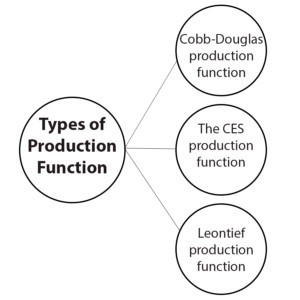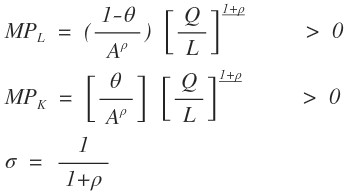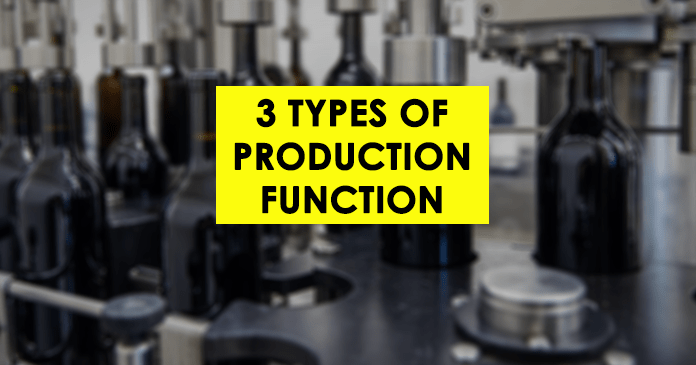There are three main types of production function. Let’s see.
- Cobb-Douglas production function
- The CES production function
- Leontief production function

First of all, we identify what is the production function.
In the production process, a set of inputs transformed into outputs. The level of output depends on the level of inputs. In other words, the output is a function of inputs.
So the device that explains this relationship between inputs and output defines as the ”production function.” However, the production function shows the technical relationship between inputs and output.
Production function can present as an algebraic equation, table/schedule, or as a graph. Mostly production function show as an algebraic equation. However, the simplest form of a production function which involved ‘n’ inputs is as follows:
q = ƒ(x1, x2, …..xn)
q – flow of output
x1, x2, …..xn – flows of inputs
Two inputs – labor (L) and capital (K)
production function can be written as:
q = ƒ(L,K)
A commodity for a production function defines under the assumption of a technology. So if the technology changes, the shape of the production function will change.
Desire properties of the Standard Production Function
1. The marginal productivity of labor is positive but diminishing.
MPL >0 MPK >0
MPLL <0 MPKK <0
2. As one factor of production or input increases, as a result of that, the output should reach a finite level. That is to say, the labor input increases up to infinite.

M1 and M2 are finite constants.
3. The output elasticity or return to scale of the production process should be shown by a standard production function.

4. Standard production function should also show the factor substitutability in the production process. That is to say, the elasticity of factor substitution for each other. Factor substitutability fully depends on the technology used in the production process. However, factor substitution that much flexible in the real world production process.
5. The production function should also be able to show the factor intensity of the production process. For example, there may be capital intensive or labor-intensive production processes.
6. A standard production function should be able to show the efficiency in the production process. So it generally shows by the technology parameter.
Types of Production Function: Cobb Douglas production function
There are three main types of production function. Certainly, the Cobb Douglas production function is a very popular type of production function.
The general form of the Cobb-Douglas production function is,

A>0
Q – total output
L – labor input
K – capital input
Parameter A – Technology of the production process
alpha – The elasticity of production of labor
beta – The elasticity of production of capital
Cobb and Douglas estimated this production function for the US economy. Especially the American manufacturing industry, using the data from 1899 to 1922. The estimated production function was,
Q=1.01L k
The Cobb Douglas production function is a homogenous production function to the first degree. Therefore it shows only the constant returns to scale.
Now let us see the other properties of the CD production function.
Properties of Cobb Douglas production function
1. A Cobb-Douglas production function shows that the marginal product of both labor and capital are positive. But, diminishing as the amount of labor and capital increase continuously.
2. The average production of labor and capital is positive.
3. A Cobb-Douglas production function shows only the constant returns to scale.
4. If we double the input, output also will double. If we triple the input and output as the same.
5. The elasticity of substitution ( Cobb-Douglas production function shows only a straight elasticity of substitution.)
6. The degree of factor intensity. ( According to the Cobb-Douglas production function, parameter A shows the technology of the production process.)
7. The Cobb-Douglas production function proves Euler’s theorem. (Euler’s theorem explains the relationship between marginal productivity theory and the theory of income distribution. It describes that the total income generated by an output should distribute among the factors of production. So it contributes to producing the output.)
Merits of the Cobb Douglas production function
So what are the merits of the CD production function?
1. The cobb-Douglas production function matches the nature of all Industries.
2. The cobb-Douglas production function is applicable to make the inter-industry and international comparison.
3. The cobb-Douglas production function is the most common use of production function in the field of econometrics. Even though the production function presents as a non-linear function, it is possible to convert into a log-linear function.
4. It can fit for time series data as well as for cross-section data.
5. The cobb-Douglas production function can also generalize in the case of ‘’n’’ number of factors of production.
6. The unknown parameters (Alpha, Beta) function can easily compute.
7. It is more popular in empirical research.
Limitations of Cobb Douglas production function
So what are the limitations of the CD production function?
1. Cobb-Douglas function considered only two inputs labor and capital
2. It shows only the constant returns to scale. It is the limited shows.
3. The assumption of stagnant technology is unrealistic.
4. The substitutability of factors can show by the function. But it neglects the interrelated factors.
5. It assumes that all industries are homogenous.
6. There is a problem with the aggregation of inputs of factors.
7. According to cobb-Douglas, function elasticity of substitution is equal to one, which is not likely, everywhere.
However, the Cobb Douglas production function is fit to determine the relative shares of labor and capital into total output.
Types of Production Function: The CES P.F (Constant Elasticity of Substitution)
The CES production function presented by four economists. Arrow, Chennery, Minhas, and Solow. Therefore it is also called an “ACMS” production function. The functional form of the CES production function is as follows.

Let’s analyze the above formula.
A – Efficiency parameter shoes the state of technology
theta- Distribution parameter
rho – Subtitution parameter

Types of Production Functions: CES formula
According to above formula there are 3 cases.
1. rho =( -1 ), then the isoquant of the production functions are straight line.
2. When rho =Infinity , then the isoquant will be angeles.
3. When rho =0 / rho =1, then it becomes like Cobb Douglas production function.
Properties of CES production function
Let’s see.
1. The value of elasticity of substitution is constant. But not necessarily equal to unity. It depends on the value of the substitution parameter.
2. The marginal product of L (labor) and K (capital) are always positive if we assume constant returns to scale.
3. The marginal product of input will increase when other input increases.
4. When the elasticity of substitution is less than unity, the function reaches a finite maximum. Thus as one-factor increases, while the other factor constant.
5. The marginal product curve is sloping downward.
6. The estimation of the elasticity of substitution parameters needs the assumption of perfect competition.
Merits of CES production function
So what are the merits of the CD production function?
1. The CES production function is more general.
2. The CES production function covers all types of returns.
3. The CES production function takes account of the parameters.
4. The CES production function takes account of raw material among its inputs.
5. The CES production function is easy for estimation.
6. The CES production function is free from unrealistic assumptions.
Limitations of CES production function
So what are the limitations of the CD production function?
1. It is very difficult and complicated to use more than two inputs.
2. It assumes the elasticity of substitution is constant. But the empirical study shows the elasticity of substitution also changes due to changes in the factor of production.
3. In estimating the parameter of the CES production function, we may meet a large number of problems such as
- The choice of exogenous variables
- Estimation procedure
- Multifunctionality
4. There are serious doubts about the possibility of identifying production function and technological change.
Types of Production Function: The Leontief production function
Father of Input-Output economics Wassily Leontief presented The Leontief Production Function (LPF). The Leontief production function is also called a fixed proportion production function.
There is the being of Leontief production function if the input-output ratio is independent of the scale of production. So it assumes strict interrelation of factors of production.
Let’s see the formula of this production function. This production function can show as follows:
q= min (z1/a, z2/b)
q = quantity of output produced
z1 = Utilised quantity of input 1
z2 = Utilised quantity of input 2
a and b are constants
Further Reading
Theory of Production: short-run, Long-run
Isoquant curve analysis of production in economics
Consumer equilibrium and indifference curve analysis
What is Indifference Curve: Definition, Assumptions, Properties


